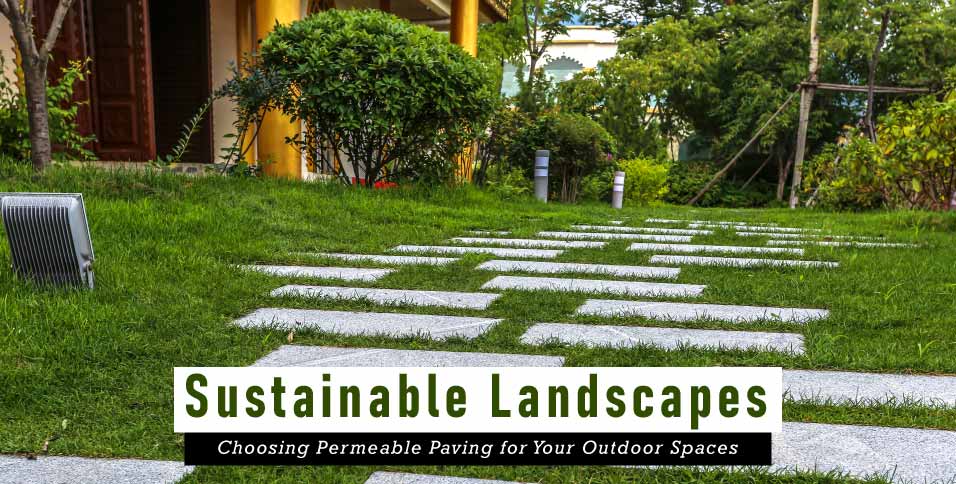As our society increasingly prioritises sustainable practices, more and more individuals are seeking eco-friendly solutions for their everyday lives. Whether it’s using energy appliances or practising waste management, people are actively looking for ways to make their homes and surroundings as environmentally conscious as possible. One essential aspect of living involves landscaping spaces, which includes the careful selection of eco-friendly materials for driveways, patios and walkways.
In recent times, permeable paving, exemplified by companies like Stone Set, has emerged as a perfect solution for creating both visually appealing and sustainable landscapes. This article aims to delve into the advantages of paving and why it stands out as a wise choice when striving to achieve sustainability goals.
Understanding Permeable Paving
Permeable paving refers to a type of surface that allows water to infiltrate through it and seep into the ground below naturally. Unlike surfaces like concrete or asphalt, permeable pavers offer significant environmental benefits by facilitating water absorption and reducing stormwater runoff.
The Environmental Benefits of Permeable Paving
1. Managing Stormwater Runoff
Traditional hardscapes contribute significantly to runoff since rainwater cannot effectively penetrate surfaces. As a result, this excess water accumulation often leads to erosion issues, strains on infrastructure, and pollution when the runoff reaches rivers and lakes.
Permeable paving provides a solution by allowing rainwater to seep into the ground instead of redirecting it. The gaps between the units enable natural filtration processes that capture pollutants typically carried by stormwater. This helps improve the recharge of groundwater while also safeguarding water bodies from contamination.
2. Reducing the Heat Island Effect
In areas with concrete or asphalt surfaces, heat islands can form due to their high absorption and retention of heat. These areas become significantly warmer than their surroundings because they lack vegetation cover.
However, permeable paving helps counteract the heat island effect by promoting vegetation and reducing heat absorption. Rainwater infiltration supports plant growth, which cools down the area through evaporation. Lowering temperatures not only creates a comfortable environment for people but also reduces the strain on air conditioning systems and decreases energy usage.
Practical Advantages of Permeable Paving
1. Enhanced Drainage and Stability
Compared to other surfaces, permeable pavers offer superior drainage capabilities. During storms, excessive rainfall tends to accumulate on surfaces as it cannot effectively penetrate and be absorbed by the ground. This pooling water often results in unstable terrain that’s both inconvenient and potentially dangerous.
On the other hand, permeable paving systems have the advantage of allowing water to naturally seep into the ground, preventing any pooling or instability on the surface during rough weather conditions. This makes them an excellent choice for areas that experience rainfall or sudden floods.
2. Durability and Longevity
Furthermore, durability and longevity are factors that homeowners consider when making choices. The good news is that permeable pavers meet both criteria by offering resilience throughout the seasons while requiring maintenance.
Unlike some materials that easily get damaged due to pressure or changes in temperature, permeable pavers are specifically designed to withstand challenges. Their interlocking structure ensures strength. They can withstand traffic without cracking or breaking over time.
Design and Aesthetic Advantages of Permeable Paving
1. Versatile Design Options
Moving on to the design and aesthetic advantages of paving, it’s important to note that there is a misconception that sustainable options limit design possibilities. However, with paving, there is a range of styles, colours, shapes and sizes available to cater to various aesthetic preferences. Whether you prefer a stone look or a sleek modern finish, you can find permeable pavers that will enhance the visual appeal of your outdoor spaces.
Moreover, these pavers offer design opportunities as they can be incorporated into patterns and designs. Homeowners and landscape professionals alike have the freedom to express their creativity while still prioritising sustainability.
2. Improved Integration with the Natural Landscape
One of the advantages of paving is its ability to blend with the surrounding natural environment seamlessly. Unlike asphalt or concrete surfaces that disrupt vegetation and hinder groundwater recharge, permeable pavers work in harmony with nature.
These friendly materials allow grass or groundcover plants to grow between the gaps, softening the edges of hard surfaces and creating a smooth transition from human-made structures to the natural world. This integration enhances biodiversity while adding to the beauty of spaces.
Conclusion
Permeable paving not only provides environmental benefits but also offers significant design advantages. With a wide range of styles and customisation options available, homeowners can create landscapes that effortlessly combine aesthetics with sustainable living principles.
By choosing paving for driveways, patios, walkways and other outdoor hardscape elements, we not only practice responsible land management but also contribute positively towards improving our quality of life through features like improved drainage and reduced cooling costs.
Remember – making choices doesn’t mean compromising on functionality or budget. Permeable paving provides a choice for those concerned about factors like water retention, maintenance requirements or budget constraints. It offers a solution that addresses needs without sacrificing visual appeal or ecological considerations
Also read:
















